#Postclassic
Text
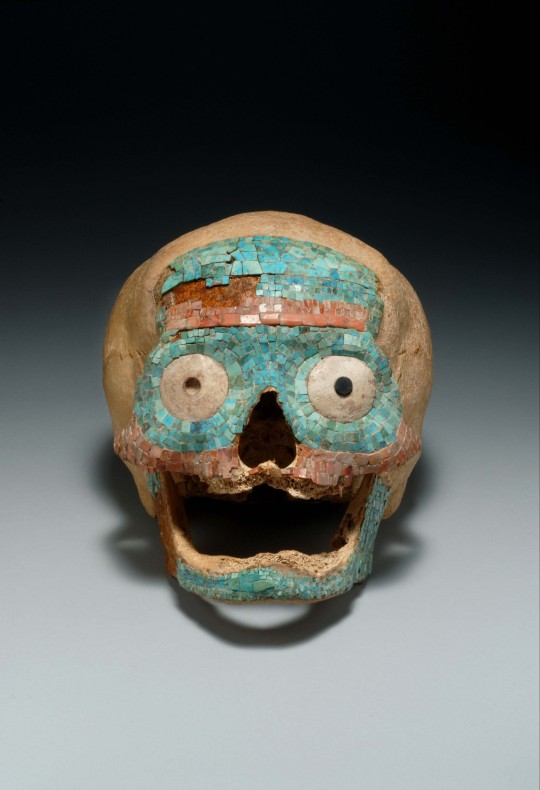
~ Human Skull With Mosaic Designs.
Culture: Mixteca-Puebla
Period: Late Postclassic
Date: A.D. 1300-1520
Medoum: Bone, stone and shell
800 notes
·
View notes
Text
By the way, so that you know, medieval monks and nuns were using their rare skill of literacy to write porn (among other things).
Source - I randomly remembered one documentary from years ago, so sorry if this is misinformation, I will try searching for proofs, but whatever I think that this image is beautiful.
My own speculation is that they probably also shared it with other people in the monastery, because things kind of were like that before the Internet if witnesses are to be believed.
2 notes
·
View notes
Text
Twin Topils, or, The Little Ruler List that Could
To begin a long, gruelling series of posts, I find it fitting to provide some manner of context beforehand.
Tollan (Xikokotitlan) in general is a bit of a historical clusterfuck, its history plagued with hundreds of years of accumulated exaggeration and further hundreds of interpreted and reinterpreted, lost and word-of-mouth'd sources. So as with many things, the truth is that no history will be truly complete, not with the materials we have today, probably never.
But one can, with a little scrawling madly at 12am, a good pen and a blank page, get closer to something old and forgotten: who the hell ruled Tollan before its demise.
Our journey begins with a long account of the years as perceived in Kwawtitlan. So the text is called, uh, Annals of Kwawtitlan.
It presents us with appearances of various rulers of various places, walking through time at a pace of its Xiwpoalli years, occasionally calling back to older events, occasionally retelling poems and prose stanzas of things said to have happened.
Walking back and making note of names, we arrive at the following list for the rulers of Tollan:

It should be noted that this is indeed a wiki table, albeit with an odd offset of 52 years from the original. This is intentional, I'd gone and did the walk back sometime ago but never bothered to reflect it on the wiki page, simply noted it in a final parenthesis to its introductory line.
Whichever the case, making a list of just this one source would be... irresponsible at best. There are other sources, the most popular of which are Ixtlilxochitl's various lists, five texts he wrote over the course of his life. These are all differently-dated, but they serve us well in most cases:

Ixtlil lists entirely different names except for one, Wetsin, though his dates are rather more distant into the past, getting somewhat closer as he writes more and (presumably) gathers and moves around now-lost sources.
What's notable about his lists is that the first one, within the Historia de la Nación Chichimeca, ends with a certain Topiltsin that's preceded by an Istakkaltsin. As time goes on, he adds changes a few names: Tlakomiwa to Mitl, Istakkaltzin to Tekpankaltsin, Xiwsaltsin to Xiwtlaltsin, and adds an Ix- to the beginning of Tlilkuechawak. He also seems to have discovered a new ruler, Mekonetsin, who he initially thought to have been another name for Topiltzin. He was instead his son, whose mother was a certain Xochitl, who we suggest had participated in the civil war of their time and deposed Topiltsin, whereafter she ruled for an unspecified number of years, then their son after her passing. This table doesn't include her for some reason.
Notes and parallels abound, but for now we will turn to Chimalpain's rather short list of rulers: Wemak (993-1029) and Akxitl Topiltsin Ketsalkoatl (1029-1051). He merely lists, it appears, those closest to the people he wrote this about, in a certain Brief memory of the founding of the city of Colhuacan.
Chimalpain had made a few mistakes elsewhere, apparently shifting a few rulers to the period of the one who preceded them. Thus, tentatively, his list would need to be re-evaluated as pertaining to a few years later, at least 22.
Most other lists are rather close to the two first ones, but there is one with a curious divergence.
The Anónimo Mexicano lists the first five all the same (Chalchiwtlanetl, Ixtlilkwechawak, Wetsin, Totepew and Nakaxok, who here is mangled as Nakaskayotl), but it jumps straight to Mitl, entirely skipping Istakkaltsin and Mekonetl. After Mitl, the regular order seems to come back with Xiwtsalli, but then we learn she ruled for only four years, after which a regency council was installed.
We are not told for how long did such a situation exist, but we are informed that a certain Tekpankaltsin ruled after its dissolution, and that he was the very last monarch of the city.
There is little more that we can use for our reconstructions, but three more sources are pivotal in orienting us. Torquemada, in his Monarquía Indiana, presents to us the knowledge that Tekpankaltsin also bore the name "Topiltsin," while the Annals of Kwawtinchan (by another name, the Historia Tolteca-Chichimeca) inform us that the last ruler of Tollan was Wemak, he whose iron fist caused instability and who became subject of the second coup in the city's history, and that a certain Wewetsin lineage of Nonoalka-chichimekah had a quarter of the city after being one of a few primary chichimeka groups to move to the area. Finally, the Codex Xolotl provides note that Tollan had been completely abandoned by 1175, a date generally supported by archaeological findings at the city reported by Healan et al.

It would appear that some common sources were used here.
Firstly, the most primordial one.
Both the AnaKwaw and Ixtlilxochitl's final list have 9 rulers, a few of which appear to be variant readings of certain glyphs: Mitl ("arrow") may be an abbreviated glyphic form of Tlakomiwa (meaning "possessor of wooden arrows"), which in turn is Mixkoatl's signature representation:
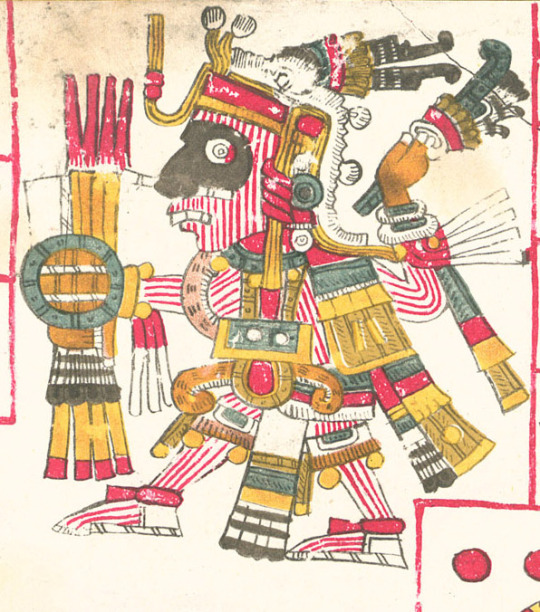
We could go on about the apparent snake around his right elbow resembling the convention for drawing masakoah, horned snakes, but this information is not entirely useful for us beyond "neat, might be whence the masatsin came from."
Also disclaimer bc ik this is actually from somewhere in the Puebla-Tlaxcala area: he hath the same traits in the Telleriano-Remensis. I just like this one a little more :)
Anyway, another name with a variant may be Xochitl, being merely "Xochitl" in Ixtlilxochitl (heh heh) and "Matlakxochitl" (10-flower, a calendarical name) in the AnaKwaw, where she directly succeeds Se Akatl.
Akxitl, meanwhile, may be a conjunct case of mangling, abbreviation and variant readings: it may very well be reconstructed as Ak[atl]-xitl, but the latter part is seldom used in names Just Like That. Instead, that may be a slight mangling of xiwitl, a word whose glyphic form is a turquoise circle, but which can be quite easily confused with the turquoise dots that make a number count when alone. Thus, a single blue dot and a reed may very well be read as Akaxiwitl, but also as Ce Akatl.
(Note: i didn't come up with all of this — the Se Akatl : Aka[tl]-xiwitl theory was proposed by a fellow scholar who goes by Jan online. Thx @261jan)
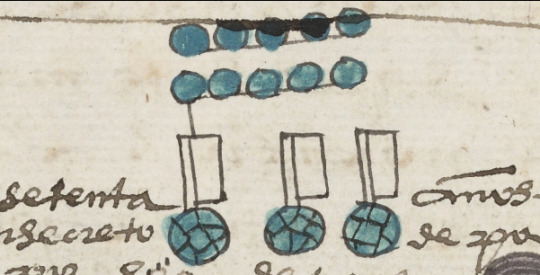
It may not have been a single ancestral source, but at least two or perhaps three (one went to AnaKwaw author(s), one to Anón. and Ixtlil, while Chimal may have an additional one that Ixtlil also consulted later on) that were involved, co-temporally produced and recording events that were basically the same, but with slightly differing glyph usage and timing.
It's easy to deduce a closer connection between Ixtlilxochitl, Chimalpain and the Anónimo, although then we'd need to take a closer look at who consulted who here.
The only one who tells us who he read outright is Chimal. Most of his' are primarily Chalko and particularly Amakemekan and Tenanko (such as the [seemingly] Título Primordial written by Rodrigo de Rosas Xohecatzin, his father-in-law), but there are a few that come to mind as likely candidates: his two "small and veritable books" — which, by the sound of them and the apparent lack of focus on lineage or years, may have been historical-cartographical works resembling the Xolotl and Huamantla codexes —, and two glossed genealogies.
He had two more written sources, a Xiuhtlapohualamoxtli (an annal) with an apparent exclusive focus on Amakemekan, and the aforementioned Título dealing with the innards and local delimitations of the same place. Additionally, we have word of two oral testimonies he solicited, one on the provenance of a genealogy and the other on the lineage of a Chalka noble.
It is quite possible he first got the names from such genealogies, particularly those concerning Kolwakan, while the dates he may have confirmed with the Xiwtlapowalamoxtli. We know this because his dates for certain rulers in all his other lists prior to a certain point in time, notably those from Kolwakan, seem to occasionally backslide into what other sources suggest are instead the periods of their predecessor; Tollan, seemingly, also has this quirk within Chimal's writings.
The Xiwtlapowalamoxtli, then, is our likely culprit.
This work was congealed from various sources, and indeed may have utilized a source that Ixtlil later got his hands on, or which his sources in turn did.
The Anónimo and Ixtlil are rather analogous rather clearly; geographically, the former appears to have been produced in the general area of Tlaxcala, which overlapped and bordered in a few places with Akolwakan, the realm where Ixtlil lived and whence he harvested his sources.

Unifying all this info, at last, we may begin to reconstruct a list of who the hell did rule Tollan, although approximate.
The Six Kings of Legend
Chalchiwtlanetl, 511-562
Ixtlilkwechawak, 562-614
Wewetl, Lineage-maker; 614-666
Ilwitimal, Totepew ("our lord"); 666-718
Nakaxok, 718-770
Divided City, 770-826
Mixkoamasatl/Tlakomiwa, First Theocrat; 826-874
Theocracy, the Heavenly Monarchs
8. Se Akatl ("Akxitl") Ketsalkoatl, 874-880
9. Matlakxochitl, 880-ca. 927
10. Mekonetl, ca. 927-983
11. Xiwtlalli, 983-987
Instability, Lieges of Rubble
12. First Regent Council, 987-1000
13. Second Regent Council, 1000-1029
14. Wemak, Stone King; 1029-ca. 1070s?
15. Third Regent Council? ca. 1070s-ca. 1100s
16. The Last Prince, 1100s-ca. 1150?
17. Second Divided City? ca. 1150-1172

Of course, the first 7 periods are 52-years long or about. They are symbolic periods, and are mostly meant symbolically. Though evidence for a Tollan at all can be glimpsed as early as the Late Formative/Preclassic, it becomes larger and more relevant when the mid-500s roll up, which is right around our starting date here.
Within these symbolic periods, the Divided City is of particular note, as it most likely represents a period of both great change, instability and parallel power between its components, being more of a "confederation" than a proper "unified polity," though this was in a rather small area of course.
Wewetsin may have been a sort of unified, mythicized leader of the Nawa migrants pouring in from the west and into the Mezquital, where some would stay in, indeed, a quarter of the city, while others would walk on and take ideas with them from the nascent trading and cultural centre south, eventually contributing to a sort of "International Style" for Epiclassic Mesoamerica — they themselves would introduce a few things where they went, including most possibly the chacmool altars, as they appear quite earlier in Chalchihuites than anywhere else, albeit in a rather indecorous form.
Ilwitimal meanwhile may have begun the construction of Tula Grande, while the period of instability under Nakaxok and the Divided City may have unfluenced the shift from Tula Chico, while TG was mostly finished in its first phase by Mixkoamasatsin, the first lord of the "renewed" Tollan in its totality.
After his rule, it appears all rulers adopted the title of Tekpankaltsin, "who dwells in the palace," while specific provenances (such as Se Akatl's training and ordainment at the temple of Ketsalkoatl, associated with the wind and everything inked white) may have also been used as the basis for titles, such as Se Akatl's alternate name, Istakkaltsin ("dweller of the white house").
Either within his period or upon the ascension of Mekonetl, Tollan's rulers began styling themselves as Topiltzin, "our honoured prince;" all these titles may have induced some confusion and mix-ups in authors with only fractional context, who perhaps read mentions of certain names in specific periods and, instead of noting them as different names for the same people, may have both separated and unified certain rulers as they believed truest — Mekonetl as the first and the Forgotten King as the last Princes, then these both and Wemak and Se Akatl as Palace-Dwellers.
Se Akatl Istakkaltsin, for his part, may have been overambitious in attempting to quickly deal with the difficulties caused by his father's movement of the city and just generally bad times; if his story is to be read in the flourish of songs and poetry, he may have turned to alcohol and other pleasures, neglecting the military and economic needs of a city in the middle of a region-wide sociopolitical transition.
Notable are the inclusions of both Matlakxochitl and Xiwtlalli in most sources, as Nawa sources post-Etetl expansion tend to omit such notable figures on the basis of their own systems, even within their own lineages — Atotostli and Ilankweitl are paramount examples of quite notable but often-erased queens.
Matlakxochitl for her part was quite the political manoeuvrer: while Se Akatl's position was crumbling by the minute, Xochitl involved herself in the plots to bring him down, managing to instead replace him and rule for an unknown amount of years, reducing unrest and paving the way for some short stability that seems to have earned Tollan its reputation as a centre of culture and prosperity towards its later years.
Xiwtlalli did step down for reasons that remain uncertain, and not much is known about her rule. Perhaps, if we choose to interpret her name in specific ways, she brought great wealth and prosperity to hr land as well, if for a short time.
In her place then sat a Regent Council, better organized than the one which preceded Wemak and with slightly more input from each unit of the city, probably named something-coatl after Mixkoamasatl, paralleling the founding of a new order of sorts.
Wemak, Xiwtlalli's son, had to wait a long time for his crown. Perhaps here he developed a propensity for throwing tantrums and being greedy, attempting to eat the world all for himself. This, it appears, made more than a few quite angry, and thus he was ousted. Many left the city for good, and in many places he's thus called the final king of the place.
And the Regency resumed.
The Last Prince, unnamed and basically unknown, knew he had it hard. He may have come from the same context as Se Akatl, or perhaps this too is merging from old sources. He too eventually fell to the city's problems, divided between those who had stayed since the beginning and those who found it relatively easy to leave their residence once more. So the city crumbled into a deep, factional state, and he simply left after realizing he had basically no power to do anything for it. He left, perhaps sea-wards, perhaps to the Royal Family's old allies in Kolwakan, and perhaps he vowed to return. In his wake, all who remained would leave as well, sooner or later.

Some say he went to Cholollan and got himself into politics there. Cholollan, however, rather outspokenly despised Tollan, for both rose immensely in power after Teotiwakan's demise. Trade was strictly forbidden between the two centres and their dependencies, so it passed through a market kingdom in Anawak Metstliapan, on the coast of the Valley of the Five Lakes. This was Cerro Portezuelo, a site a little to the south of Tetskoko, possibly the Otumba Chimalpain mentions as one of the three regional hegemons of Tollan's age.
And with that, we can wrap this up at last, and prepare for the shitfest to come when we touch on such figures as Maarten and Mautner, and understand the mytho-historical relevance of this place. All in good time, all in good time.

Sources:
José Rubén Romero Galván (1977): Las fuentes de las diferentes historias originales del Chimalpahin
Dan M. Healan, Robert H. Cobean, & Robert T. Bowsher (2021): Revised Chronology and Settlement History of Tula and the Tula Region
Keith Jordan (2016): From Tula Chico to Chichén Itzá: Implications of the Epiclassic Sculpture of Tula for the Nature and Timing of Tula-Chichén Contact
Hanns J. Prem (1999): Los reyes de Tollan y Colhuacan
Alonso Bejarano & Pedro de San Buenaventura (n.d) via Primo Feliciano Velázquez (1992): Anales de Cuauhtitlan
Domingo Francisco de San Antón Muñón Chimalpahin Quauhtlehuanitzin (ca. 1631) via Víctor M. Castillo F. (1991): Memorial breve acerca de la fundación de la ciudad de Culhuacan
Unknown (n.d) via Richley H. Crapo & Bonnie Glass-Coffin (2005): Anónimo Mexicano
— via Paul Kirchoff, Lina Odena Güemes & Luis Reyes García (1976): Historia Tolteca-Chichimeca
— (ca. 1450s?): "Codex Xolotl"
Juan de Torquemada (1615): Monarquía Indiana, book I, chapter XIV
#the tula series (tm)#middle classic#epiclassic#middle postclassic#effortpost outtakes#it'd be a whole effortpost if it wasn't just 5 pages but whatever#ಠ_ಠ#< tfw using ixtlil *and* torquemada
6 notes
·
View notes
Note
There’s a bit of a difference between skeletons being in such poor condition that archeologists cannot tell the sex, and the fact that when skeletons are in good condition sex is easily observable. I fucking despair that you’re about to graduate and you cannot tell the difference between the two circumstances
Why yes, I can tell the difference. We were talking, afterall, about a hypothetical future in which taphonomic processes and just general decay of the living matter in the bone tissue is going to take place! Did you even think before sending in this ask? You're almost as dumb as the person who said coffins exist now implying they didn't in the past.
#to be completely fair to you#I've excavated in the maya area and most burials are directly on the ground which because the ground is acidic does accelerate the process#coffins and funerary urns and the like do help but decay processes aren't entirely averted#so yeah try harder#I'm only humoring you because I went to see Wakanda Forever today#and I came out of the cinema pleasantly surprised so I'm in a good mood#completely off topic but I was so relieved that movie didn't pull an ancient aliens#it would've been so easy to make the villains atlanteans or some shit#but they didn't! it was a postclassic yucatec kingdom that descended into the water rather than emerge from it!#hollywood be hollywood and marvel be marvel#but it was much better than I expected!
5 notes
·
View notes
Photo

El más reciente Ambient Sessions está hecho por su servidor, intenté hacer una sesión inmersiva y profunda, un espacio para un poco de calma y paz. Espero que puedan escucharlo y lo disfruten. Música de Gallery Six, Yann Novak, Sarah Davachi & Sean McCann, Julianna Barwick, Arovane & Hior Chronik, Ryuichi Sakamoto, GALÁN / VOGT, Markus Guentner & Joachim Spieth, Chihei Hatakeyama, Alejandro Morse, Sachi Kobayashi mixcloud.com/Ambient_Sessions/ambient-sessions-09-klaus-cam/ . #AmbientSessions #AmbientSessionsMixSeries #AmbientSessions09 #klauscam #ambient #drone #meditative #deep #postclassical #modernclassical #atmospheric #healing #IDM #electronic https://www.instagram.com/p/CemC-4OOBLT/?igshid=NGJjMDIxMWI=
#ambientsessions#ambientsessionsmixseries#ambientsessions09#klauscam#ambient#drone#meditative#deep#postclassical#modernclassical#atmospheric#healing#idm#electronic
2 notes
·
View notes
Audio
Check out this new track by BC Smith!
0 notes
Text
youtube
0 notes
Audio
(Margaret Maria)
#SoundCloud#music#Margaret Maria#postclassical new classical virtuoso new music cubase musicproducer cello cellist composer neumann
1 note
·
View note
Text
Fat ass gay
Slutty Plumper Buxom Bella Pleasures Him till He Cums on Her Tits
Reverse Cowgirl With Cumming At The End
Black Friday Blowjob From My Stepsis
Twink teen boy body hair and young emo hot gay porn James Is Hungry
Cum tribute for Noiva Loirinha
Bangali anal force fuck
Mother Fucks Sons Friends at Party
Nude male swimming gay porn Zaden pumps in and out, shoving his
Juicy and wild party
#quadrennium#bulkiest#noncharacteristically#overtrust#cromlech#quesited#episematic#stiff-grown#tranche#postclassical#vermicularly#Neo-Lamarckism#mannitose#previgilant#double-branched#cold-catching#co-versed#gingivoglossitis#GHRS#unplan
0 notes
Photo

Christina Vantzou - No. 5 No. 5, the fifth collection of modern classical compositions from Kansas City-born, Brussels-based composer Christina Vantzou, is more like a dream than an album. Sequences rise and fall with their own rhyme and reason, unrelated to any musical structure or sense of narrative. A dank, dripping cavern opens up onto a night sky, radiant with shooting stars; in the distance, footsteps crunch on gravel and the sound of crickets. My review of @christinavantzou's fabulous No. 5, on @krankyltd, is up now on Spectrum Culture! Click the link in bio to read the full review. . . . . . #ChristinaVantzou #No5 #Kranky #KrankyRecords #classical #classicalmusic #modernclassical #postclassical #electroacoustic #electroacousticmusic #electronicmusic #experimental #experimentalmusic #soundcollage #senseofplace #sonicpsychogeography #sonicdiary #RegionalMusic #Greece #GreekMusic #AnoKoufonisi #albumreview #albumcover #musicdesign #artifact #TheInvisibleMuseum #musicjournalism #JSimpson #SpectrumCulture #ForestpunkRecommends https://www.instagram.com/p/CnyMrVZOjce/?igshid=NGJjMDIxMWI=
#christinavantzou#no5#kranky#krankyrecords#classical#classicalmusic#modernclassical#postclassical#electroacoustic#electroacousticmusic#electronicmusic#experimental#experimentalmusic#soundcollage#senseofplace#sonicpsychogeography#sonicdiary#regionalmusic#greece#greekmusic#anokoufonisi#albumreview#albumcover#musicdesign#artifact#theinvisiblemuseum#musicjournalism#jsimpson#spectrumculture#forestpunkrecommends
0 notes
Text
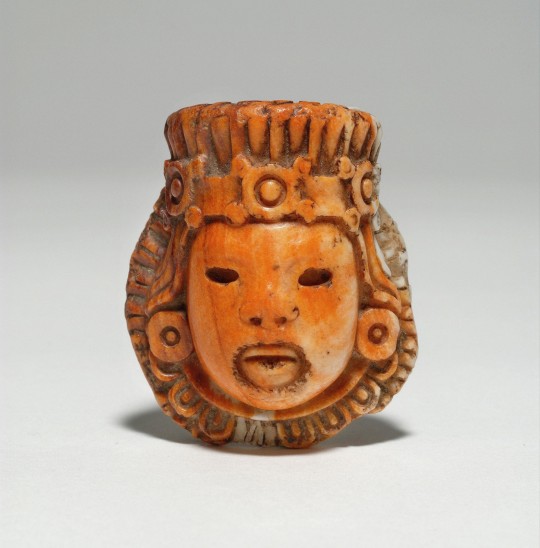

~ Head of Xipe Totec.
Culture: Aztec
Period: Late Postclassic
Date: ca. A.D. 1500
Medium: Shell
#16th century#history#museum#archeology#archaeology#xipe totec#aztec#Mexico#mexican#Mesoamerica#Postclassic#shell#ca. A.D. 1500
396 notes
·
View notes
Text
Don't want to dunk on that person specifically, but the idea that people that look black to us in Medieval art prove existence of black people in Medieval Europe is bad on a lot of accounts, but one of it is that Medieval art isn't known for its realism. Most of the time it was drawn from description alone, and even when an artist specifically wanted to make their skin different they rarely knew the actual skin tones. Like I think I saw a man on Medieval illustration that was literally black as coal and he was supposed to be an Arab. Luke the artist just read "Arabs have darker look" or something like that and drew what they imagined it to be like. And there are other things about Medieval art not being very realistic.
Which is not to say that there weren't non-white people in Europe. For one there was like a lot of Arabs and other people from SWANA all across the Mediterranean coast with some individuals travelling anywhere, and people from any part of Eurasia or Africa could (and did) just come there, but like search actual proves.
#not going to comment on the part about 'you can't complain about poc in historical dramas' because yes you can't but that's not the reason#people in historical dramas also have far too perfect teeth and skin and women wear makeup and men are too athletic and such#the only reason race is considered more unrealistic than this is because race is political and nice people don't complain about it#also i remember that scandal with tv series about trojan war with most characters being black#and for some reason most people arguing literally forgot to mention that it was filmed in an african country and mostly for local tv#like yeah wonder why most of the actors in african tv are black#history#txt#postclassical period
1 note
·
View note
Photo
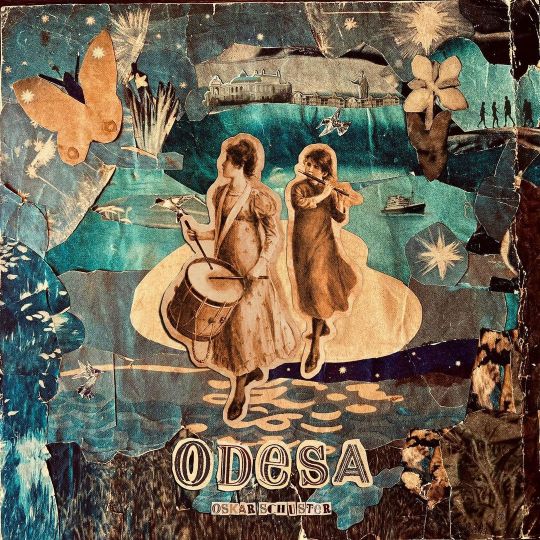
Last year I was working together with Oskar @oskar.schuster on the cover artwork of his new EP "Odesa". This cover is mainly made in the style of an analog collage, which was made by us and one unknown author✨(but this is some other story!). If you look closely on this picture, maybe you can see the connection with Ukraine and Odesa. Listen to Oskar’s magical album on your favourite streaming service ✨. . . . . . . . . #instamusic #music #oskarschuster #newrelease #odesa #odessa #brass #postclassical #angiesiveria #art #artist #collage #analogcollage #collageart #collageartwork #instaart #instaartist #musiccover #coverdesign #fairytale #dreaming #dream #traum #surrealism #surrealart #одесса #одеса #ukraine #dreamy #inblue (at Berlin, Germany) https://www.instagram.com/p/CnHr-RoN-gW/?igshid=NGJjMDIxMWI=
#instamusic#music#oskarschuster#newrelease#odesa#odessa#brass#postclassical#angiesiveria#art#artist#collage#analogcollage#collageart#collageartwork#instaart#instaartist#musiccover#coverdesign#fairytale#dreaming#dream#traum#surrealism#surrealart#одесса#одеса#ukraine#dreamy#inblue
0 notes
Photo
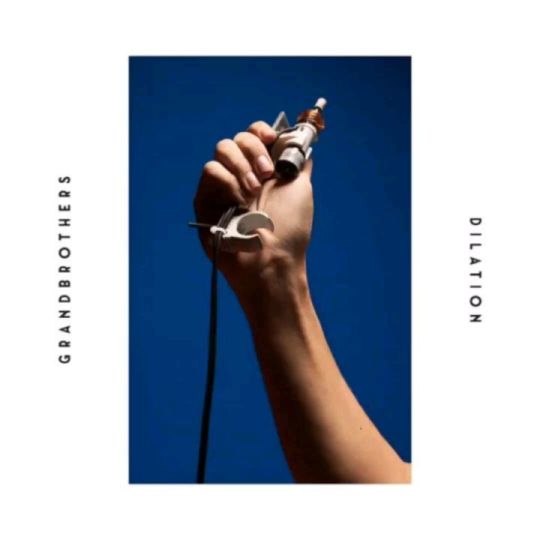
GRANDBROTHERS / DILATION : FILM (2LP) Erol SarpとLukas VogelからなるデュオGrandbrothersの2015年の1stアルバムが嬉しい再プレス!Gilles Petyersonに絶讃され、コンピレーション『Brownswood Bubblers Ten』にも参加、グランド・ピアノと電子音楽の融合した優雅で緻密なサウンドにファン急増中!ポストクラシカル、アンビエント好きはもちろん、NEW AGEファン、ECM好きにも大推薦の美しすぎる大推薦盤です!(KEYWON) #Grandbrothers#FILM#modernclassical#postclassical#ambient#newage#lp#vinyl#record#stradarecords#dj#vinyljunkies#kobe#motomachi#strada#recordshop#recordstore#神戸レコード#元町レコード#レコード店#レコード#アナログ https://www.stradarecords.com/shop/item/28101/index.php (Strada Records) https://www.instagram.com/p/ClzzeMJPH8h/?igshid=NGJjMDIxMWI=
#grandbrothers#film#modernclassical#postclassical#ambient#newage#lp#vinyl#record#stradarecords#dj#vinyljunkies#kobe#motomachi#strada#recordshop#recordstore#神戸レコード#元町レコード#レコード店#レコード#アナログ
0 notes
Note
How many languages do you speak?
You are always talking about alchemist that lived all around the world in very differente time periods. And you have mentioned several times that there's a ton of numerology hidden in their texts, counting syllables and letters of certain words and paragraphs. So one would assume you need to read them in the original language it was written, right?
That's a really good question! As with most really good questions, the answer is "kinda, it depends!"
So! Most alchemical texts are written in some form of coded language, but the nature of that code depends on the era and culture the text is being written in. Depending on how its written, modern scholars have a lot of different tools for cracking open alchemical esoterica.
Most ancient Greek/Byzantine texts are written in postclassical Greek. But, they're often written in dense philosophical prose. The reader needs to be familiar with the likes of Plato, Aristotle, and the early Neoplatonists, to make sense of them. Luckily for us, people have been studying postclassical Greek for nearly 2000 years. There are many excellent translations into English.
Late Egyptian alchemists wrote almost entirely in pictograph code. Not as in hieroglyphics, mind you. Egyptian alchemical recipes often made use of custom character sets and symbols that represented alchemical concepts. (One famous example, the Formula of the Crab, uses a complex diagram that looks like a centipede to represent a particular gold compound.) These are damn near impossible to read without expert help.
At the same time, Jewish and Syriac writers of the era could get by on the fact that not everyone could read Hebrew and Syriac lol. The language barrier itself acted as a sort of copyright system for protecting their ideas. Luckily for us, many of these texts were preserved and translated by medieval Arab scholars!
Speaking of Arabic, once you hit the Islamic Golden Age, the amount of alchemical literature increases by a factor of ten. Thing is, the Islamic Polymaths weren't all that interested in obscuring their work. The Islamic Golden Age was all about copying and translating older works, and compiling them into big textbook/dictionaries. They're not intentionally encoded, they're comparatively easy to read once you get a good translation. Thing is, you gotta know your Neoplatonism. Medieval Islamicate scholars love Neoplatonism.
Then we get the reintroduction of alchemy to Europe around the 10th century. What you get is about 400 years of monks painstakingly translating medieval Arabic into Latin. A lot of these texts are very well preserved, and have good translations into English.
Then, around the late 14th century, European entrepreneurial alchemy kicks into high gear, and THIS is where we get all those fancy numerology encoded alchemical texts. Renaissance alchemists loved themselves some puzzles. This would be fine if they were all just writing in Latin, but the printing press meant they could write in any damn language they please. You get a lot of French, German, Dutch, Italian, and antiquated English alchemical texts, and they can be a bitch to read without help.
BUT the introduction of the printing press also gave us something useful: cheap picture books! Late renaissance alchemists loved writing in word games and coded metaphor, but they also loved including esoteric diagrams. And the thing about esoteric diagrams is --if you know your stuff-- you don't need to speak 15th century french to read a picture. Which isn't a replacement for reading the original translation, not even close, but the explicit purpose of these images was to prove to other alchemists that the author knows what they're talking about. So if you can read them, you can get a damn good sense as to what the text is about.
This was fun to write so I'm gonna plug my patreon if you wanna see me write more about alchemy.
1K notes
·
View notes
Text

Labret
Mixteca-Puebla, Postclassic, ca. 1500 CE
Labrets or lip plugs (bezotes in Spanish) were decorations worn through a hole pierced in the lower lip. They have an uneven distribution in the ancient Americas and appear sporadically in such places as coastal Alaska, the Northwest Coast, and at various other points along the Pacific Coast. They also appeared in Central Mexico, where they became one of the defining culture traits of Mesoamerica.
233 notes
·
View notes